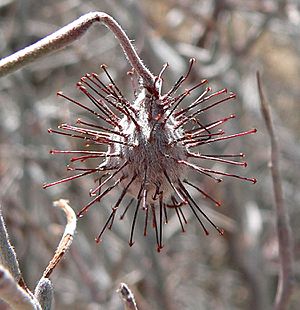White rhatany facts for kids
Quick facts for kids White rhatany |
|
|---|---|
 |
|
| barbed fruit | |
| Scientific classification | |
| Genus: |
Krameria
|
| Species: |
bicolor
|
| Synonyms | |
|
Krameria grayi Rose & Painter |
|
The Krameria bicolor is a special kind of plant known as a perennial shrub. This means it lives for many years and has a woody stem. It belongs to the Krameriaceae family, which are often called rhatanies. You might know it by its common names like white rhatany or crimson-beak. In Spanish, people call it chacate or cosahui in the state of Sonora, Mexico.
You can find this unique shrub growing in dry places. It lives in the southwestern United States, stretching from California all the way to Texas. It also grows in the northern parts of Mexico.
Contents
Discovering the White Rhatany
The white rhatany is a low-growing plant. It has many branches that grow close together. Usually, it reaches about 2 feet (1 m) tall, but sometimes it can grow even taller, over 5.0 feet (2 m). Its branches look a bit spiny, but they aren't sharp or hard at the ends.
What the Plant Looks Like
The leaves of the white rhatany are small and narrow. They are usually about half to three-quarters of an inch long. They have a grey-green or greenish color and are covered in fine, soft hairs. The whole plant, including its branches, can be grayish-green, white-gray, or even dull brown with hints of red.
Flowers and Special Uses
The flowers of the white rhatany are often small and can be hard to spot. However, in some areas, the plants can bloom with many bright red flowers. These beautiful flowers make the plant stand out. The plant is also very useful! People, like the Seri people in Mexico, use parts of this plant to make colorful dyes for their baskets.
How It Survives in the Desert
This shrub is perfectly suited for dry, desert environments. It can even take advantage of times when there is more moisture in the soil. What's really interesting about the white rhatany is that it's a partially parasitic plant. This means it gets some of its food and water from other plants. For example, it often attaches itself to the creosote bush, which is called Larrea tridentata. This special ability helps it survive in tough desert conditions.

